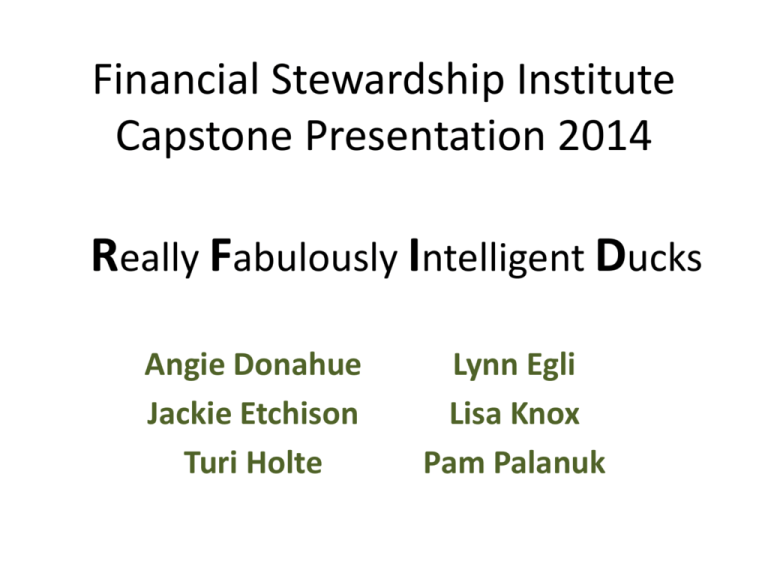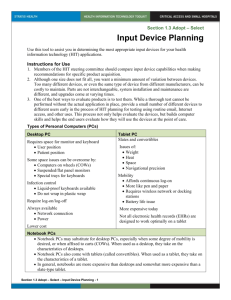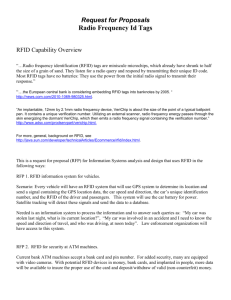FSI Capstone 2014 RFID
advertisement

Financial Stewardship Institute Capstone Presentation 2014 Really Fabulously Intelligent Ducks Angie Donahue Jackie Etchison Turi Holte Lynn Egli Lisa Knox Pam Palanuk Our Purpose Our team was tasked with making a recommendation for the procurement and maintenance of a Radio Frequency Identification (RFID) tracking system for bedroom and lounge furniture used in residence halls. This system will be used to track and maintain furniture inventory used in individual bedrooms and common areas such as lounges, classrooms, and study spaces. What’s In a Residence Hall? Room configuration (example) What is Data Capture? What is RFID? Case Study: AeroScout System, Oregon State University Disability Access Services System Overview: Real-time tracking of 460 pieces of high value equipment, tags are battery powered and utilize the OSU Wi-Fi network. System Expenses: Initial implementation costs $78K, breakdown below. - $50K purchase price of system - Tags $25 each (500*25 = $12,500) - Annual maintenance of the system is $15,700 - IT involvement is necessary for both implementation and management of the system. This additional cost was not factored in the total. Case Study: AeroScout System, Oregon State University Disability Access Services • Cost Benefit Analysis While the system has all of the features Housing would like in an RFID system, to be considered, the system must cost under $100K. Wi-Fi tags, at $25 each, are too expensive for this to be a feasible solution. a) Tag cost would need to stay under $1.75 tag, as 20,000 tags are needed b) 20,000*$1.75 = $35K c) System $50K, Support $15K, Tags $35K = $100K Threshold Sacred Heart Medical Center - RiverBend System Overview: Real-time tracking of hundreds of IV pumps, valued at $3K each, and a scarce critical resource. Tags are battery powered and utilize the secure Versus network, not Wi-Fi, but the technology is very similar. System Expense: Tags are approximately $25 each. No additional RFID system costs obtained, as tag costs alone make system unaffordable for Housing. Cost Benefit Analysis: This solution will also not meet the needs of Housing due to high cost. Case Study: UO College of Arts and Sciences QR Code Optical Read & Database Option System Overview: QR ("Quick Response") Code is a barcode that contains data that can be read by a phone's camera, once a reader application has been downloaded. The phone's camera acts like a scanner, allowing it to "read" the barcode, and then directly link the user to a website. In this particular application, once the QR is scanned, the barcode will take you to that specific item’s information, which is pulled from a database and posted on the web via Drupal, an open sourced software package. Case Study: UO College of Arts and Sciences QR Code Optical Read & Database Option Possible Solution for UO Housing? Pros: • The cost to implement would be low, requiring only a programmer to change the data fields currently being used to new categories and a hand held smart phone/tablet/etc. • Complete online inventory system, with the ability to have a count of all items and sort by specific categories by exporting data into Excel. Cons: • Optical system would require “line of sight” (close proximity) scanning. • Labor would be required to input the data into the database. Fields can come pre-populated to assist in the data entry process. • High risk of user error. Checkpoint with Housing Scoring Solution Alternatives Optical Solution similar to UO-developed College of Arts and Sciences application Did not meet Housing’s requirements due to need for “line of sight, close proximity scanning” Very affordable system with minimal support costs Paper tags may not last 5-10 years Optical Quick Reader (QR) Solution / Evaluation Criteria Locate and read chip info without entering the students dorm room Optical Green Meets criteria Yellow Unknown Red Does not meet criteria Affordable System Useful Life 5-10 years Minimal Support Cost Checkpoint with Housing Scoring Solution Alternatives Close proximity radio frequency read 1-3 inches does not meet UO Housing requirements Unknown cost RFID Passive Low Frequency Solution / Evaluation Criteria Locate and read chip info without entering the students dorm room Optical RFID passive LF Green Meets criteria Yellow Unknown Red Does not meet criteria Affordable System Useful Life 5-10 years Minimal Support Cost Checkpoint with Housing Scoring Solution Alternatives Very capable long-distance (up to 30 feet) solution Links to UO WIFI network Very expense at $25/tag Does not meet affordability criteria RFID Active Solution / Evaluation Criteria Locate and read chip info without entering the students dorm room Optical RFID passive LF RFID Active Green Meets criteria Yellow Unknown Red Does not meet criteria Affordable System Useful Life 5-10 years Minimal Support Cost Checkpoint with Housing Scoring Solution Alternatives Possible solution in RFID Passive UHF (unknown) RFID Passive Ultra-high Frequency (UHF) Solution / Evaluation Criteria No experts on RFID in housing or on FSI team Housing Procurement recommendation to proceed with Request for Information (RFI) Locate and read chip info without entering the students dorm room Optical RFID passive LF RFID Active RFID Passive UHF Green Meets criteria Yellow Unknown Red Does not meet criteria Affordable System Useful Life 5-10 years Minimal Support Cost Checkpoint with Housing Interim Report: Options 1. 2. 3. 4. Explore optical solution instead of radio frequency identification (RFID) Hire consultant Post UO Request for Information Cancel project Procurement Process Options • Purchase Order – Standard UO terms, $25K or less in five year period • Request for Information – – – – Exploratory. Posted publically with Description of Use and University Questions No quotes obtained. Only publically available information On-site presentations optional No obligation to move to procurement of any kind • Request for Quote (Informal Procurement) – – – – – Generally custom terms and conditions $25-$150K over 5 year period Advertised at least 5 business days, at least 3 quotes, MWESB Obtain quotes with description of product/services Score submissions • Request for Proposal (Formal Procurement) – – – – Generally custom terms and conditions >$150K over 5 year period Significant statutory procurement requirements On-site presentations normally required Current State of the Project • A special thank you to Cathey Susman and Allie O’Conner in PCS for providing a special training to our team for procurement options. • RFI generated multiple responses. • Request for Proposals Questions?







